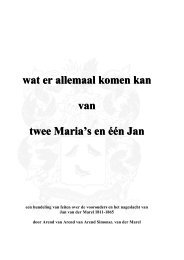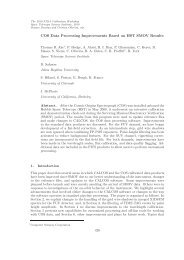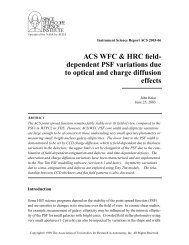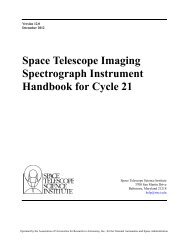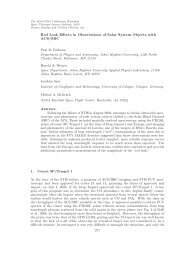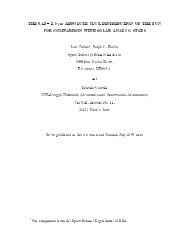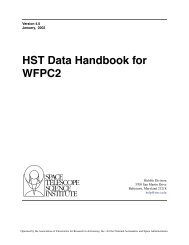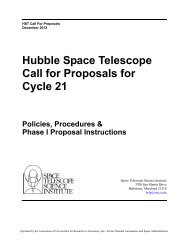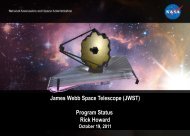STScI Annual Report 2002: A Living Mission
STScI Annual Report 2002: A Living Mission
STScI Annual Report 2002: A Living Mission
You also want an ePaper? Increase the reach of your titles
YUMPU automatically turns print PDFs into web optimized ePapers that Google loves.
44 achievements<br />
At the workshop, the ACS group described a geometric distortion model. They reported that the<br />
anneal rate of hot pixels on the ACS Wide Field Camera (WFC) is lower than other Hubble CCDs (chargecoupled<br />
devices). The flat-fields provide ~ 1% photometric accuracy over the entire field of view. On-orbit<br />
measurements indicate higher than expected sensitivity for WFC, up to 20% in the blue.<br />
The NICMOS group reported that the cryocooler is providing a very stable temperature, which<br />
facilitated re-calibration. The new operating temperature has increased the instrument’s sensitivity.<br />
Others at the workshop presented new calibrations and insights about existing or retired instruments—STIS,<br />
WFPC2, the Faint Object Spectrograph (FOS), and the Fine Guidance Sensors (FGS).<br />
The Institute previewed calibration plans for the Cosmic Origins Spectrograph (COS) and Wide Field<br />
Camera 3 (WFC3), which will be installed on the next servicing mission.<br />
During <strong>2002</strong>, we improved the accuracy of the pipeline flux calibration of STIS MAMA (Multi-Anode<br />
Microchannel Array) spectroscopic modes. From the time of its installation on Hubble, the throughputs<br />
of these modes have varied by wavelength-dependent amounts ranging between 1% and 3% per year.<br />
Now, we have calibrated this time variation, and the STIS pipeline calibrates the fluxes for first order<br />
spectra with an accuracy ~ 1%. Also, there had been a problem with the blaze function shifting on an<br />
echelle spectrum when it was offset on the detector. This produced an incorrect flux calibration, which<br />
was especially severe at the ends of an order. We introduced an algorithm, developed by the STIS instrument<br />
team, that dramatically improves the flux calibration for all primary STIS echelle settings.<br />
We improved STIS background corrections. The transition to the backup side-2 electronics in mid<br />
2001 had left STIS without a working temperature-control circuit for the CCD detector. The resulting<br />
temperature fluctuations cause significant variations in the detector’s dark current and hot-pixel intensities.<br />
Fortunately, we could show that the read out of another temperature sensor on the CCD housing is<br />
well correlated with the CCD dark current, and we now use these readings in the pipeline to scale the<br />
reference dark file to the appropriate temperature to correct each data set.<br />
The phosphorescence of impurities in the MgF 2 faceplate dominates the dark current of the nearultraviolet<br />
MAMA detector. This dark current varies in a complex way depending on the thermal history of<br />
the detector. In mid <strong>2002</strong>, we introduced an algorithm in the pipeline that delivers a new dark reference<br />
for each data set based on the tracked record of detector temperatures. This calibration is correct to<br />
within 5% to 10% about 95% of the time, which largely eliminates the bright edges previously visible in<br />
many dark-limited near-ultraviolet MAMA images.<br />
For the first time in four years, the Institute has revised the data handbooks (DHBs), which are the<br />
primary user’s guides to understanding and analyzing Hubble data. Now, each instrument has its own<br />
DHB, describing data acquisition, pipeline processing, archiving, file formats, and software for analyzing<br />
data. Each DHB provides an overview of the instrument, the structure of its data files, calibration, and<br />
data analysis details. The Institute website offers the DHBs in PDF and HTML formats. This new publication<br />
scheme makes it easier to incorporate new information and get it to users quickly.<br />
Stimulate the use of Hubble data<br />
The Institute provides the astronomy community with easy access to the entire suite of Hubble data. After<br />
an observation, we process, calibrate, and archive new observational data promptly. Also, we make all<br />
non-proprietary science data available to the public.<br />
The Treasury and Archive Legacy programs, begun in Cycle 11, will result in new forms of data<br />
products for distribution to the community via the Archive. The Institute has defined standards and procedures<br />
for the winning Treasury and Legacy teams to provide these processed materials to the archive.<br />
The ACS Early Release observations were extremely popular in the community, as first demonstrations<br />
of the capabilities of the new camera. The GOODS survey images, which have no proprietary period,<br />
have also proven to be very popular. To support the interest in these data sets, the archive set up an ftp<br />
site for easy access to these data products.<br />
We upgraded services to archive users through our ongoing collaborations with the Canadian<br />
Astronomy Data Centre (CADC) and Space Telescope European Coordination Facility (ST-ECF). In<br />
November, this partnership announced the availability of over 16,000 WFPC2 ‘associations’, which are<br />
co-added, cosmic-ray rejected images drawn from observations of the same target for different programs.<br />
This provides a quick method for astronomers to get the deepest images possible for a target,<br />
without having to extract and process all the sub-images.



